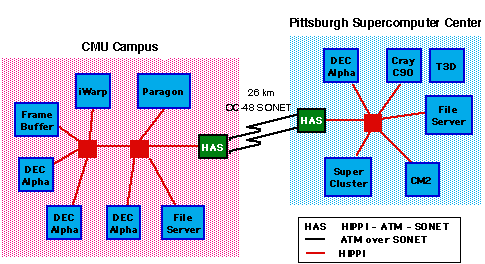

The HIPPI-ATM-SONET (HAS) connects the HIPPI LANs with the ATM-SONET MAN. The HAS interfaces are built by Bellcore based on a joint Bellcore-CMU architecture. The HAS has a general architecture for a LAN-WAN or LAN-WAN interface: it terminates the HIPPI connection, so it can connect LANs of different types. The HAS uses packet striping: each packet travels over a single OC3 channel. To achieve bandwidths higher than 155 Mbit/second, different packets of the same stream are sent over different channels.
The testbed focuses on two applications: the solution of large traveling salesman problems (Joe Pekny, Purdue) and planning in the presence of uncertainty (Greg McRae, MIT/CMU). The first application mainly runs on groups of workstation and it makes use of the DCABB environment to implement efficient distributed algorithms for linear programming. The second application is a more traditional supercomputer application and can make use of a variety of computational resources. For example, a chemical flowsheeting program ran across the Cray C90, the CM2 and iWarp.
Programming tools are critical to the success of distributed programming, and when distributing applications across Nectar-like multicomputers, tools often execute at runtime since they have to react to the behavior of the system. The Nectar testbed uses the Dome distributed object package to look at how tools can benefit from high-speed networks. Dome supports application-transparent checkpointing and load balancing. Bee is used for monitoring.